Dan Mushalko, Johnny DiLoretto, Katherine R. O’Brien, & Robert E. Pyatt
Abstract
There are many published examples of strategies for using movies in science education, ranging from individual activities within a class to complete courses like “The Biology of Jurassic Park” at Hood College or “The Physics of Film” at the University of Central Florida (Borgwald and Schreiner 1994; Dubeck et al. 1988; Dubeck et al. 1995; Firooznia 2006). However, all of these strategies employ the use of the film within a formal classroom setting. This paper describes a collaborative program connecting hands-on science activities and new release motion pictures for informal science education in the innovative setting of a movie theater.
Initial Development
The Gateway Film Center (GFC) is a not-for-profit theater which includes eight screens, an art gallery, an upper level bar/ lounge area, a large lobby, and a lower level nautical-themed restaurant. In 2015, the theater was recognized by the Sundance Art House Project as an independent theater of excellence based on “high standards including: quality programming, deep involvement with their local communities, strong financial standing, and recognition from their peers and their communities”(Madden 2015)
The GFC initially began experimenting with science-related supplemental programming through discussions following showings of the film Gravity and the TV series Cosmos in 2013. Based on the success of those events and a love of science by the GFC staff, the theater was interested in broadening that concept to a wider range of new release films. Beginning in 2014, we formed a collaboration with the GFC to develop supplemental science programming related to and in support of films shown at the theater. The mission of the Gateway Film Center includes an educational component, but this traditionally had referred to cultivating film appreciation, movie criticism, and production skills (http://gatewayfilmcenter.org/films-cool/). However, they also promoted their facility as a “learning lab” to promote curiosity and the seeking of new knowledge (http://gatewayfilmcenter.org/films-cool/). We felt that this inspiring philosophy could also apply to science education and the use of the theater as an informal learning environment. This initiative was founded on the goals of (1) integrating science engagement into a unique part of popular culture, (2) exposing moviegoers to real scientists and real science questions, (3) facilitating learning in an informal environment.
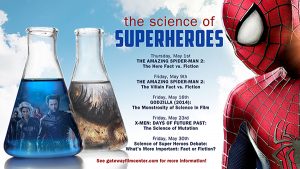
FIGURE 1. Advertisement from the GFC promoting Science of Superheroes discussions.
During the 2014 summer blockbuster season, we spearheaded a series of panel discussions hosted by ourselves and other scientists from our immediate area in conjunction with three new films. As one journalist noted in a piece to promote these events, “You can’t spell ‘science fiction’ without ‘science'” (Madden 2014). Discussions were held after the 7 p.m. show on consecutive Fridays during the month of May and included topics such as “The Monstrosity of Science in Film” for the movie Godzilla and “The Science of Mutation” for X-Men: Days of Future Past (Figure 1). The series concluded with a discussion on the relative importance of scientific fact or narrative development in motion pictures. All panel discussions were held in the upper level lounge area of the theater and announced at the end of the film screening to encourage people to stay afterwards and attend. Most seats in the lounge area were usually filled for each panel and attendees were typically adults. Discussions were lively and included both expert commentary and audience questions to allow individuals the opportunity to directly interact with scien
tists around topics they were familiar with (e.g., comic books, superheroes, and monsters). When possible, we also supplemented panels with interactive displays such as a collection of insects for “The Hero: Fact vs. Fiction” discussion for the film The Amazing Spiderman 2.
Science and the Geek Sneaks
While the panel discussion format had proven successful, we wanted to develop science programming that was more interactive, broadly appealing to younger audiences/ families, and would extend across a larger range of time/ movie show times. We expanded the scope of our efforts and began developing science-related content for the Geek Sneak series at the GFC. Geek Sneaks are advertised as “the ultimate geeking-out atmosphere: parties, unique pre-show entertainment (think behind the scenes and rare footage) and themed drink and dining specials, with a group that loves the movie as much as you do!” (http://gatewayfilmcenter.org/featured_film_series/geek-sneaks/). Geek Sneaks are held the Thursday before a film opens nationwide and consist of multiple showings of that movie during the evening hours. As promotion for the Geek Sneaks highlighted special pre-show entertainment, this seemed like an excellent environment in which to incorporate an informal science education component.
Science activities related to each film are designed to be of short duration (completed in roughly ten minutes or less) and suitable for small groups of people (the typical sizes commonly attending movies). All activities are designed to be hands-on and focused around science content related to themes in the associated film. The GFC hosts multiple Geek Sneak programs throughout the year, but only those movies with science-related premises were deemed suitable for related science activities. In addition to our work, the GFC also arranged other science guests for some Geek Sneaks to further develop the educational message and promotion around some films.
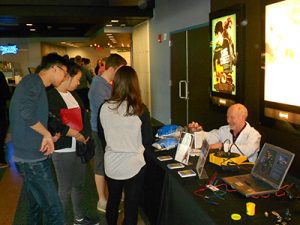
FIGURE 2. Author D. Mushalko leads some theatergoers through an activity for the movie Ant-Man, using air pressure to increase or decrease the size of marshmallows.
The GFC has eight screens, and Geek Sneak science activities were typically hosted in the lobby area, which allowed them to be accessible to all moviegoers and not just those attending the Geek Sneak. For example, the Marvel Studios movie Ant-Man opened in June of 2015 and tells the story of a superhero who has the ability to shrink in scale thanks to a super suit created by his scientist mentor. As a superhero fantasy, there are many components of the story that lack scientific accuracy, such as the suit’s implausible ability to shrink a person to insect size, Ant-Man’s superhuman strength, and the ability of a human to go sub-atomic and survive in the quantum realm at the film’s conclusion. However with a plot and hero based at least in part on real science principles, we felt that this movie offered an excellent opportunity to couple some related science activities. Two such activities were set up in the theater lobby from 6 p.m. to 8 p.m. the evening of the Geek Sneak so that they were prominently visible to all theatergoers. The science activities for Ant-Man included one focused on air pressure as a mechanism to shrink or enlarge marshmallows using a hand pump or a vacuum chamber, as this most directly connects with the movie’s plot and the hero’s abilities (Figures 2 and 3). Each activity was accompanied by basic background information on the topic, which in this case included a brief definition of air pressure, a description of the composition of marshmallows, and a short discussion of how changing pressure makes them grow or shrink. Participants were also given markers and encouraged to create their own Ant-Man character with the marshmallow before experimentation. Additionally an entomologist and representatives from a local conservatory were also invited to present displays on ants and insects respectively.
For the film Jurassic World, we conducted DNA extractions from wheat germ so that moviegoers could take a sample of DNA they had processed themselves into the theater for the show, and a display of fossils was presented by the Ohio State University Orton Geological Museum including an impressive T-Rex skull. For the film Fantastic Four, science activities included light refraction experiments to mimic the powers of the Invisible Woman, and melting a small piece of the metal gallium (melting temperature 85.58°F) in the hand to mimic the heat of the Human Torch. For Star Wars: The Force Awakens, activities based around the Force focused on magnetism and static electricity (Figures 4 and 5). We have continued to develop film-related science activities with the GFC and have adopted a hybrid approach based on our experiences. For films with broader appeal that are more likely to pull in family audiences, we continue to develop hands-on, film-related science activities for Geek Sneaks associated with those movies. For the film X-Men Apocalypse we presented activities allowing theatergoers to search the human genome using a computer or test their own genetics of bitter taste [Figure 6]. For the film Star Trek Beyond, attendees could examine the warping of space or explore the International Space Station through a NASA computer simulation (Figure 7). Most recently, for the release of Shin Godzilla we showed the random nature of radioactive half-life using M&Ms and demonstrated the use of a Geiger counter with common household radioactive items.
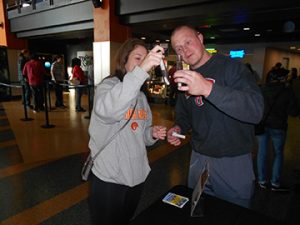
FIGURE 3. 2 Participants use hand pumps to pressurize tubes containing marshmallows to shrink them in an activity for the movie Ant-Man.

FIGURE 4. An enthusiastic attendee demonstrates the non- contact force of magnetic attraction during activities for the film Star Wars: The Force Awakens.
For documentaries or other films aimed at more adult audiences, we have moved to hosting panel discussions in the theater’s restaurant area to continue conversations about film-related topics after the film has ended. For example, recent screenings of the documentaries The Last Man on the Moon and Science, Sex and the Ladies were followed by lively discussions on the future of manned flight and female sexuality. While documentaries typically do not have the same appeal as Hollywood blockbusters, we find many adult audience members are more interested in digging into the respective topics in greater detail through discussion sessions following the showings.
Audience Reactions and Challenges
Moviegoers have been generally positive towards this unusual science programming, and we frequently receive comments like “That’s really cool!” or “Why do you guys do this?” We see individuals coming to Geek Sneaks and checking in with us to see what new science activities we have planned for that film. For Batman v Superman: Dawn of Justice, we conducted “super” experiments to see how a person’s grip strength and total lung capacity would compare to Superman’s given some of the feats we’ve seen him demonstrate in movies. We also recorded both measures on a large board for all participants as a comparison across Geek Sneak attendees that evening. We found that not only did moviegoers enjoy these activities, but some came back repeatedly throughout the evening to check their scores compared to others. A few even asked to repeat the activities to try to improve their scores, allowing us to discuss ways they could do that long term. We would also see one individual from a group complete the activities and then go and bring their friends over to try it as well. Most encouraging, however, is seeing groups who have completed the activities walk away discussing their results, which serves as further reinforcement of those concepts. We love watching informal science learning happening in a movie theater.
Given that the reason people are at the GFC is to see a movie, we try to be respectful of their time as they interact with us. We don’t want to make anyone late for a movie. If attendees decline to participate, we graciously thank them for looking and comment that we hope they enjoy their movie. When individuals do participate, we often will ask when their show time is and modify our presentation accordingly if their time is limited. The popularity of a given movie directly relates to the number of attendees we will see for a Geek Sneak. For a film with reasonable popularity like Batman v Superman: Dawn of Justice, we saw forty people participating in at least one of the activities during the roughly two hours we were present for the Geek Sneak.
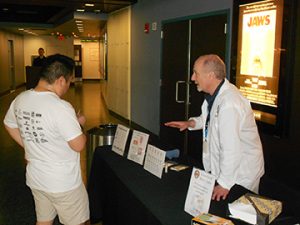
FIGURE 6. Author D. Mushalko leads a theatergoer through an activity for the movie X-Men: Apocalypse, exploring the genetics of bitter taste.

FIGURE 5. Author R. Pyatt leads some movie attendees in experimenting with the force of magnetism in an activity for the film Star Wars: The Force Awakens.
The participation of moviegoers was observed during the American premiere of Shin Godzilla. Two activities were run simultaneously for 45 minutes, and 34 moviegoers participated in at least one of the activities; most people did both. Participation was measured if an individual spent at least one minute on an activity. Gender (male; female) and age (child; teenager; adult) were recorded, as perceived by the observer, and each participant was also asked what movie they came to see as part of the demonstrators being cognizant of movie start times. Participation was scored by counting the unique ways moviegoers participated, including if the participant asked a question, answered a question, participated in the hands-on activity, watched the Geiger counter demonstration, helped another participant with the hands-on activity, or shared a story with the demonstrators. Participation scores ranged from a 1 (for someone who, for example, just watched an activity) to a 5 (for someone who, for example, actively participated). An example of a high participation score is the first female participant. She saw another movie but was interested in the activity because her mother is a statistician. While at the table, participant 1 asked and answered questions, shared her mother’s occupation, observed the Geiger counter and participated in the hands-on activity. The average level of participation for a participant was 2.5, indicating that they engaged in between two and three unique activity modalities.
Most participants were adults (82%), possibly due to the lateness of the show, as well as the movie being in Japanese with English subtitles, which skews viewership based on reading comprehension levels. Furthermore, most participants were men (70%); however, this seemed representative of the gender skew of moviegoers who came for the Godzilla movie. Of the 10 women who participated, three (30%) women came to Gateway to view another movie, while of the 24 men only four (16%) came to see a movie other than Godzilla. There was no statistical difference between how much men and women participated, though they participated in different ways. Men were more likely to be the first to start the hands-on activity, ask a question, or share a story, while women were more likely to answer a question or help with the hands-on activity.
Conclusions
A recent report by a committee convened through the National Research Council described the venues of informal learning as occurring in the context of three areas: everyday (life) experiences such as personal hobbies, designed settings like museums, and after-school and adult programs (Bell et al. 2009). Studies by Falk et al. have show
n that the public has a broad interest in science, and a 2007 survey identified the “lifelong predominantly free choice nature of science learning” as the primary method of science education (Falk et al. 2001; Falk et al. 2007). Based on their results, the authors then recommend “a more holistic approach to science education” which “integrates school, work, and leisure time learning experiences” (Falk et al. 2007, 464). While extensive research has focused on designed settings such as museums or planetariums and informal programs such as out-of-school clubs and citizen science projects, there is considerably less information about informal science education in everyday settings.

FIGURE 7. With the help of author R. Pyatt, attendees explore the International Space Station using a NASA computer simulation.
A recent publication by Bultitude and Sardo described a new subclass of everyday settings they termed as “generic,” which included locations designed primarily for leisure activities, where participants have chosen to be, but for reasons unrelated to science or science learning (Bultitude and Sardo 2012). In their article, the authors describe three such everyday settings including a collective of science communicators called Guerilla Science presenting at a music festival, a physics demonstration set up at a garden festival, and a biological survey (Bioblitz) conducted at a large country park. Through interviews and structured observations, the authors found that attendees of these “generic” events valued “audience participation opportunities and hands-on nature of some activities.” The authors subsequently concluded that “holding activities within a relaxed but not habitual environment, where participants are at their leisure, offers clear advantages in reaching non-standard audiences”(Bultitude and Sardo 2012, 32). Our experiences using the innovative setting of a movie theater as one such “generic” everyday setting for informal science education would confirm this. While we have only anecdotal responses from participants, we have observed that hands-on activities and discussions in the theater stoked curiosity and promoted science learning in theatergoers. Especially following panel discussions, we observed that participants seemed to connect to a movie’s science content in more personal ways. Finally, these science activities and discussions were excellent material for the Gateway Film Center to use in advertising and promotions which solidified the collaborative nature of this program.
At a recent Geek Sneak during the summer of 2016, we were approached by an attendee who was excited to talk to us. He had attended a previous Geek Sneak for X-Men Apocalypse and had participated in the activity around bitter taste genetics and the TAS2R38 gene. He excitedly told us that since that film he’d read a couple of articles which mentioned the TAS2R38 gene; he had remembered the gene from our activity and had gone to look up additional information on it himself. While it is only a single piece of anecdotal evidence, this is exactly the impact we are aiming for.
About the Authors
 Dan Mushalko is General Manager, Operations and Program Director at the National Public Radio affiliate 90.5 WCBE, a division of the Columbus City Schools District. He is also the host of “The Amazing Science Emporium,” which mixes music, puns, and other offbeat elements to teach science. Mr. Mushalko holds several journalism and education awards, including the American Association for the Advancement of Science’s Science Journalism Award. He focuses his avocational activities on education, teaching writing at Thurber House (a non-profit literary center) and conducting in-school science demonstrations. science@columbus.rr.com
Dan Mushalko is General Manager, Operations and Program Director at the National Public Radio affiliate 90.5 WCBE, a division of the Columbus City Schools District. He is also the host of “The Amazing Science Emporium,” which mixes music, puns, and other offbeat elements to teach science. Mr. Mushalko holds several journalism and education awards, including the American Association for the Advancement of Science’s Science Journalism Award. He focuses his avocational activities on education, teaching writing at Thurber House (a non-profit literary center) and conducting in-school science demonstrations. science@columbus.rr.com
 Johnny DiLoretto is a longtime Columbus media personality and performer. Johnny graduated from The Ohio State University with a Bachelor of Arts degree in English and Film Studies in 1997 and began his career in print in 1998 as a film critic for The Other Paper. He transitioned to television in 2002 when he became the entertainment reporter, film and food critic for WSYX ABC 6 and WTTE Fox 28. From 2012 to 2016, he was the director of communications at the Gateway Film Center, an independent, non-profit movie theater dedicated to the art of cinema and its transformational and educational potential. jadiloretto@gmail.com
Johnny DiLoretto is a longtime Columbus media personality and performer. Johnny graduated from The Ohio State University with a Bachelor of Arts degree in English and Film Studies in 1997 and began his career in print in 1998 as a film critic for The Other Paper. He transitioned to television in 2002 when he became the entertainment reporter, film and food critic for WSYX ABC 6 and WTTE Fox 28. From 2012 to 2016, he was the director of communications at the Gateway Film Center, an independent, non-profit movie theater dedicated to the art of cinema and its transformational and educational potential. jadiloretto@gmail.com
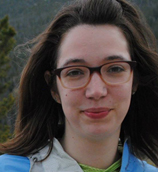 Katherine R. O’Brien is a contractor with the Center for Life Science Education at the Ohio State University. She received her M.A. from Clark University and her Ph.D. from the University of Pennsylvania. Dr. O’Brien supports increasing diversity in STEM by developing connections between universities, the arts, museums, and the communities they serve. Obrien.758@osu.edu
Katherine R. O’Brien is a contractor with the Center for Life Science Education at the Ohio State University. She received her M.A. from Clark University and her Ph.D. from the University of Pennsylvania. Dr. O’Brien supports increasing diversity in STEM by developing connections between universities, the arts, museums, and the communities they serve. Obrien.758@osu.edu
 Robert E. Pyatt is an Associate Director of the Cytogenetics and Molecular Genetics Laboratories at Nationwide Children’s Hospital and an Associate Professor-Clinical in the Department of Pathology at The Ohio State University. He received his M.S. from Purdue University and his Ph.D. from The Ohio State University. Dr Pyatt is passionate about science education, especially developing new avenues of informal delivery. Robert.Pyatt@nationwidechildrens.org
Robert E. Pyatt is an Associate Director of the Cytogenetics and Molecular Genetics Laboratories at Nationwide Children’s Hospital and an Associate Professor-Clinical in the Department of Pathology at The Ohio State University. He received his M.S. from Purdue University and his Ph.D. from The Ohio State University. Dr Pyatt is passionate about science education, especially developing new avenues of informal delivery. Robert.Pyatt@nationwidechildrens.org
References
Bell, P.B., B. Lewenstein, A.W. Shouse, and M.A. Feder. 2009. Learning Science in Informal Environments: People, Places, and Pursuits. Washington, DC: National Academies Press.
Borgwald, J.M., and S. Schreiner. 1994. “Science and the Movies: The Good, the Bad, and the Ugly: A Novel Interdisciplinary Course for Teaching Science to Nonscience Majors.” Journal of College Science Teaching 23 (6): 367–371.
Bultitude K., and A.M. Sardo. 2012. “Leisure and Pleasure: Science Events in Unusual Places.” International Journal of Science Education 34: 2775–2795.
Dubeck, L.W., S.E. Moshier, and J.E. Boss. 1988. “Science in Cinema: Teaching Science Fact through Science Fiction Films.” New York: Teachers College Press.
Dubeck, L.W., S.E. Moshier, and J.E. Boss. 1995. “Using Science Fiction Films to Teach Science at the College Level.” Journal of College Science Teaching 25 (1): 46–50.
Falk, J.H., P. Brooks, and R. Amin. 2001. Free Choice Science Education: How We Learn Outside of School. New York: Teachers College Press.
Falk, J.H., M. Storksdieck, and L.D. Dirrking. 2007 “Investigating Public Science Interest and Understanding: Evidence for the Importance of Free-Choice Learning.” Public Understanding of Science 16: 455–469.
Firooznia, F. 2006. “Giant Ants and Walking Plants: Using Science Fiction to Teach a Writing Intensive, Lab-Based Biology Class for Nonmajors.” Journal of College Science Teaching 35 (5): 26–31.
Gateway Film Center. n.d. “Education.” http://gatewayfilmcenter.org/films-cool/ (accessed December 17, 2016).
Gateway Film Center. n.d. “Geek Sneaks.” http://gatewayfilmcenter.org/featured_film_series/geek-sneaks/ (accessed December 17, 2016).
Madden, H. 2014. “Discuss Science and Superheroes at Gateway Film Center.” http://www.columbusunderground.com/discuss-science-and-superheroes-at-gateway-film-center-hm1 (accessed December 17, 2016).
Madden, H. 2015. “Gateway Film Center Wins Sundance Honor.” http://www.columbusunderground.com/gateway-film-center-hm1 (accessed December 17, 2016).
Mission Statement
The mission of this journal is to explore constructive connections between science education and civic engagement that will enhance both experiences for our students. In the 21st century, mathematical and scientific reasoning is an essential element for full participation in a democratic society. Contributions to this journal will focus on using unsolved, complex civic issues as a framework to develop students’ understanding of the role of scientific knowledge in personal and public decision making, along with examining how such knowledge is embedded in a broader social and political context. Since many pressing issues are not constrained by national borders, we encourage perspectives that are international or global in scope. In addition to examining what students learn, we will also explore how this learning takes place and how it can be evaluated, documented, and strengthened. By exploring civic questions as unsolved challenges, we seek to empower students as engaged participants in their learning on campus and as citizens in their communities.
Publishing the Journal
The Journal is published twice per year in an online format. The official publisher of the journal is The Department of Technology and Society at Stony Brook University, home of the National Center for Science and Civic Engagement. Editorial offices for the Journal are located in Lancaster, PA at Franklin & Marshall College.
Editorial Board
Publisher:
Wm. David Burns, National Center for Science and Civic Engagement
david.burns@sencer.net
Co-Editors in Chief:
Trace Jordan, New York University, U.S.A.
trace.jordan@nyu.edu
Eliza Reilly, NCSCE, U.S.A.
eliza.reilly@stonybrook.edu
Managing Editor:
Marcy Dubroff, The POGIL Project, U.S.A.
marcy.dubroff@fandm.edu
Editorial Board Members:
Sherryl Broverman, Duke University, U.S.A.
sbrover@duke.edu
Shree Dhawale, Indiana University – Purdue University Fort Wayne, U.S.A.
dhawale@ipfw.edu
David Ferguson, Stony Brook University, U.S.A.
dferguson@notes.cc.sunysb.edu
Matthew Fisher, St. Vincent College, U.S.A.
matt.fisher@email.stvincent.edu
Robert Franco, Kapiolani Community College, U.S.A.
bfranco@hawaii.edu
Ellen Goldey, Wofford College, U.S.A.
goldeyes@wofford.edu
Nana Japaridze, I. Beritashvili Institute of Physiology, Republic of Georgia
nadia_japaridze@yahoo.com
Cindy Kaus, Metropolitan State University, U.S.A.
cindy.kaus@metrostate.edu
Theo Koupelis, Broward College, U.S.A.
tkoupeli@broward.edu
Jay Labov, National Research Council, U.S.A.
jlabov@nas.edu
Debra Meyer, University of Johannesburg, Republic of South Africa
debra.meyer@up.ac.za
Kirk Miller, Franklin & Marshall College, U.S.A.
kirk.miller@fandm.edu
Amy Shachter, Santa Clara University, U.S.A.
ashachter@scu.edu
Garon Smith, University of Montana, U.S.A.
garon.smith@umontana.edu

View editorial board member biosketches.
Submission Guidelines
View the submission guidelines.
Archives















